Picture this – you’re on the side of a rural country road, no other motorists in sight, and your car battery dies.
What should you do if your car battery dies and you’re stranded? In this article, we’ll tell you how you can get yourself out of this frustrating (and potentially terrifying!) situation in a pinch.
Car batteries tend to last several years (two to five, in most cases) before you need to recondition them, but there are several things that can shorten their lives prematurely. Cold weather, extended lack of use, and leaving the headlights on overnight (guilty!) can cause your car battery to die early or unexpectedly.
Regardless of how you found yourself in this situation, there are several potential solutions you can turn to in order to get yourself out of it.
Here’s what you need to know.
What to Do If Your Car Battery Dies – and You’re Stranded: 7 Solutions
1. Invest in a Jump Start Kit
A jump start kit, also known as a battery charging pack, is an invaluable tool to have on hand if you’re concerned about your battery dying – or if you just want to be more self-sufficient. This kind of tool is perfect if you find yourself in the middle of nowhere with no cell phone reception or other drivers to help you jump your battery.
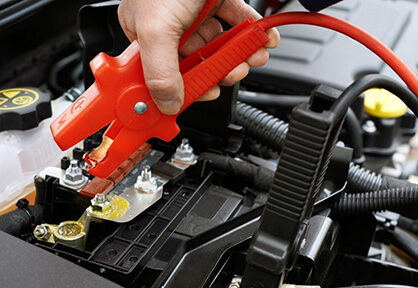
These kits are more expensive than jumper cables, costing up to $200, but they are worth the expense if you live or frequently drive in an area that is relatively remote. These kits often provide several dozen starts per charge and can be used on most kinds of batteries as they work by transferring energy from the portable battery inside the kit to the dead battery inside your car.
You’ll simply attach the clamps to your battery just like you would if you were jumping a car as usual (a process described in detail below). Then you’ll power on the jump start kit, start your vehicle, and detach. It’s as simple as that!
There are several options you can choose from, but this kit is a reliable and effective choice.
2. Ask for a Jump
Now this one’s obvious. But this step-by-step guide wouldn’t be complete if we didn’t provide information about getting a jump start from another car.
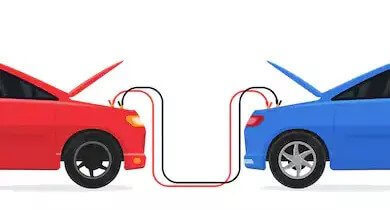
If you don’t have a jump start kit, you should try and get a jump from another car passing by (hopefully you won’t have to wait for too long!). And this is why it’s a good idea to always have a set of good jumper cables on hand, like these.
To jump your car, make sure your vehicles are positioned appropriately (like in the illustration above) with the two vehicles facing each other. If you are using a vehicle with a manual transmission, put it in neutral. And keep a vehicle with an automatic transmission in park. Secure the parking brake in both cars and turn off the running car.
Identify the positive and negative battery terminals (the positive terminal will have a red indicator, or plus sign, while the negative terminal will have a black indicator or negative sign).
Next, attach the jumper cables in the correct order. The order you attach the jumper cables is important (for safety) so please read the next instructions carefully:
- FIRST: Attach the red clip of the jumper cables to the POSITIVE terminal of your battery. Identifying the POSITIVE terminal is easy – it will either have “POS” or “+” on it OR it will be the bigger terminal (and the negative terminal will be smaller).
- SECOND: Attach other red clip to the POSITIVE terminal of the other car (i.e. the car with the working battery).
- THIRD: Attach one of the black clips on the jumper cables to the NEGATIVE terminal on the other car’s battery (i.e. the car with the working battery).
- FOURTH: The other black clip must now be attached to a metal unpainted surface on your car that isn’t near the carburetor (if your car has one) or the battery.
View the Diagram below:
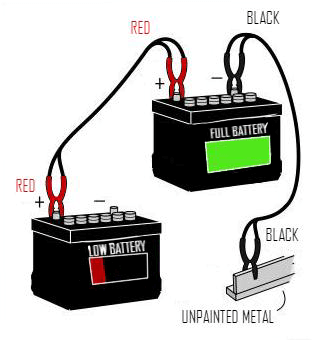
- FIFTH: Next, start the vehicle with the functioning battery and let it run for a minute or two before attempting to start your car. Then try and start your car. Let the car with the working battery idle at 3000 RPMs to transfer enough energy before you disconnect the cables.
- SIXTH: If it is not starting, check the jumper cables and make sure they’re connected correctly. Then have your friend or helper with the other car run their car engine for five minutes. Next, try starting your car again. If this does not work for you then your car battery needs to be reconditioned with EZ Battery Reconditioning™ or replaced.
3. Corroded Terminals? Try This
Sometimes, a car battery won’t start because the terminals are corroded and the cables can’t make a good connection with the terminals. If that’s the case, there are several tricks you can try and tools you can use to remove the corrosion.
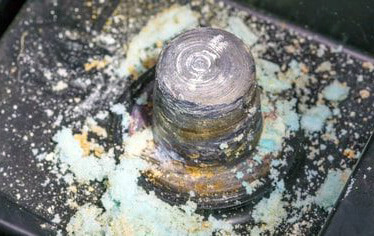
If you’re in a jam and don’t have the corrosion removal tools that we describe below, you can try and use a bit of vinegar or hot water to remove the corrosion – but something that also works, that you may have in your car, is Coke (or Coca Cola, that is!).
To remove corrosion with either vinegar or Coke, apply a small amount to the battery terminals, then wait for a few minutes before wiping it clean with the rag. You may need to do this a few times to dissolve the corrosion, but it should help you clean them up quickly if you’re stranded and you don’t have anything else in your car to do the job.
Just keep in mind that you will want to remove anything you apply to the corroded area once you’ve been able to remove the corrosion. Coke in particular is quite sticky, and leaving it on a battery can leave sticky and acidic residue behind. Leaving this on the battery for a long time can cause gradual damage and degrade your battery. So once you get to where you need to go, wipe it off with warm water.
But an even better solution for removing corrosion is to keep two preventative items in your car instead so that you don’t have to cobble a solution together with vinegar or Coke. These two items are terminal cleaner (sometimes referred to as battery cleaner) and a terminal brush.
Terminal cleaner is designed to clean up corrosion without leaving any harmful residues on the battery. And a terminal cleaning brush can be used on both top and side terminals and will help remove any corrosion so the car cables can get a good connection to the battery.
These tools are inexpensive, easy to use, and can be kept in your car at all times – Here’s a good terminal cleaner and here’s a good terminal brush.
4. Try Some (Uncoated) Aspirin and distilled water
Uncoated Aspirin can slightly alter your battery’s electrolyte mix and help it start if you’re in a jam and you’re stranded. Plus, aspirin is something that most people tend to carry with them, so it can be a good quick fix in a pinch.
To use aspirin to get your battery going again, dissolve 12 aspirin tablets of 235 milligrams or 500 milligrams in about six ounces of distilled warm water. Add equal amounts to each battery cell, then add more distilled water if needed to make sure the battery cells are covered.
The theory behind how this works is simple. Aspirin contains acetylsalicylic acid, which combines with battery acid and can then increase the charge in your battery. The water in the mixture will restore the electrolyte levels in the battery when combined with the aspirin.
If all else fails, it’s a good idea to have some aspirin on hand anyway – if for nothing else than the tension headache you might develop from being stranded!
5. Try a Rolling Start (if you have a manual transmission)
If you have a manual transmission, you can always give a rolling start a try. You’ll need somebody to help you – like a passenger – but in a pinch, it will help you get your engine going again.

Shift your car into second gear and press down on a clutch. Turn the key in the ignition, then have your friend push the car so it has as much forward momentum as possible (as you might expect, this works best if you’re on the top of a hill or slight incline).
Then release the clutch once you get rolling, then leave the car in second gear and the ignition on. If it worked, your car should stay started and you’ll be moving again – just be sure to pick up the passenger before you move on out of town!
6. Carry a Spare Battery
This tip is not particularly effective if you’ve already found yourself on the side of the road. However, if you’re hoping to prevent being stranded in the future, always carry a spare battery with you so you can swap it out as needed. And be sure that the spare is fully charged and maintained on a regular basis!
7. Call in a Professional
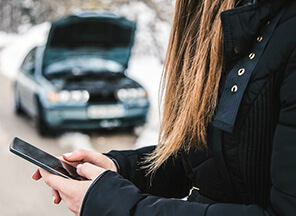
Worst case scenario, you may need to call in the heavy hitters and get some professional help. Especially if you aren’t comfortable trying any of the steps listed above on your own.
Call in a towing service or AAA to get you going. They’ll either provide you with a new battery, give you a jump, or tow your car to the nearest service station.
Prevention is the Best Solution
If you’re reading this guide as you scroll through your phone on the side of the road, waiting for a jump, then these concluding remarks probably won’t do you much good.
However, it’s best to remember, in the future, that it’s always easier to prevent a situation than to remedy it. In the case of a dead battery, your best option is to prevent battery damage or misusing the battery in a way that leads to it prematurely or unexpectedly dying. Recharge the battery regularly and make sure your vehicle charging system is functioning properly. And once the battery starts aging, recondition it with the EZ Battery Reconditioning™ methods.
Keep an eye out for warning signs that your battery is about to die, too. If your engine turns over slowly or you notice warning lights appearing on your dash, you will want to recondition it, fully charge it, or invest in another battery.
However, if you find that your car battery has died and you are stranded, try not to panic. Take a few deep breaths, relax, and consider following one of the tips above. You’ll be back on the road in no time!



4 replies to "What To Do If Your Car Battery Dies And You’re Stranded (direct)"
Thank you. These are some of the most clear instructions I’ve ever seen for jump starting a car. I tried the Coca-Cola trick for corrosion and it was really helpful too.
Love the aspirin trick. Thank you.
Very helpful jump starting method. Thanks.
I picked up the Jump Starter Battery Booster Charger Power Bank off. Has all sorts of features including hazard lights if your car is really dead, and other outputs including USB.
Used it a couple of times, not on my car, and it’s really handy to have around. Make sure you keep it topped up, you don’t know when you will need it. I check mine monthly to make sure I have 4 LED indicators showing it’s still fully charged.